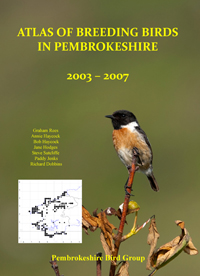Egretta garzetta
The main locality where Little Egrets were seen during the expansion period was the Cleddau Estuary, which has many scattered inlets. The systematic monthly WeBS counts, running from September to March, became the foundation for monitoring numerical presence and population trends (Haycock, 2006). Cover for the months April to August were assessed from general observations reported, augmented by information gathered as a side product of the PCNPA’s annual Shelduckling surveys (Hodges, 1991-2006)
The possible alternative of counting birds attending roosts turned out to be less useful, as those located, such as at Brunt Wood and Carew Mill Pond, were not consistently occupied over time.
Maximum counts – Cleddau Estuary

The majority (64 %) of Little Egrets recorded at the Cleddau Estuary up to 1988 were in the spring, predominantly in May. Thereafter, up to 2002, most arrived during the winter months and from 2003 peak numbers occurred in September.
Musgrove (2002) established a pattern had emerged in Britain of peak arrival in September with a smaller peak again in March. A small March peak seems to have also occurred on the Cleddau Estuary since 2003. These developments have taken place during the period when Little Egrets were progressively colonising southern England as a breeding bird.
The smaller estuaries of the Nevern and the Teifi have also proved attractive to Little Egrets, in numbers appropriate to their size. Two to four birds has been the normal presence at the Nevern Estuary from 1993, but up to five were noted in 2001 and 2005 and none were seen in 1998 and 1999. There was an average presence of four at the Teifi Estuary over the same period, with five in 2006, six in 2003 and 2005 and 12 for a brief part of November 2001.
The Little Egret has displayed a degree of restlessness and exploration during its range expansion into Pembrokeshire. It expanded its feeding range to areas adjacent to the estuaries where cattle and cattle feeders were present and was seen picking over freshly ploughed land.
It has also been encountered at many rocky localities around the coast, such as Martin’s Haven, Trefin and Cwm yr Eglwys, visiting the offshore islands of Skokholm, Skomer, Ramsey and even Grassholm, sheltered areas like Fishguard Harbour and Solva, streams and ponds like Newgale Marsh, Afon Alun, Trefeiddan, Bosherston , Heathfield, Withybush, Manorteifi and further inland at Ffynone and Llys y fran Reservoir.
Graham Rees
(Covers records up to and including 2011)
References
HAYCOCK. A. 2008. A review of the status of wetland birds in the Milford Haven Waterway and Daugleddau Estuary, A report to the Milford Haven Waterway Environmental Surveillance Group. Unpublished.
HODGES. J. E, Reports for 1991 – 2006. Daugleddau and Milford Haven Waterway, Surveillance of summer Shelduck populations, Pembrokeshire Coast National Park Authority. Unpublished.
MUSGROVE. A. J. 2002. The non-breeding status of the Little Egret in Britain, British Birds, Vol. 95, 62 – 80.
 Sunday, September 1, 2013 at 9:14AM
Sunday, September 1, 2013 at 9:14AM  1949 BoP in
1949 BoP in  Little Egret
Little Egret 


